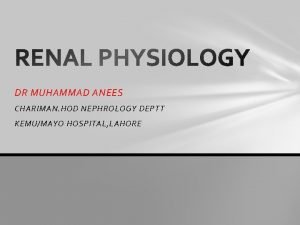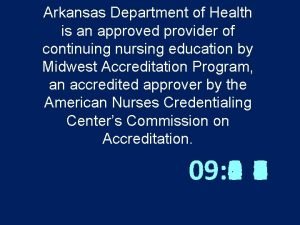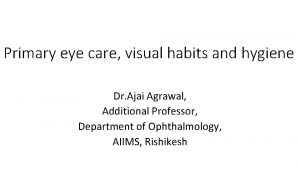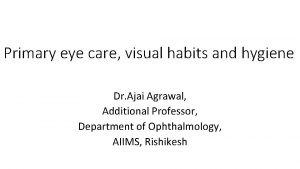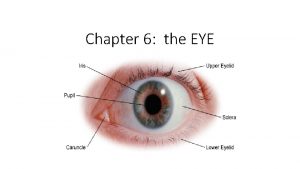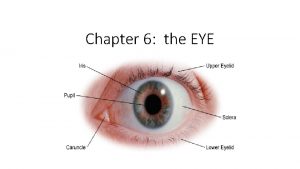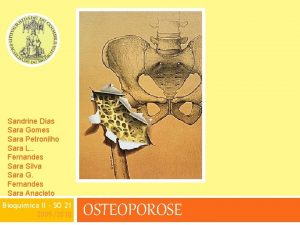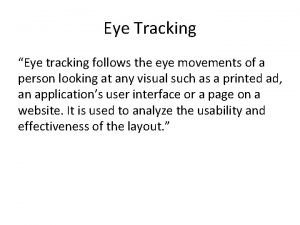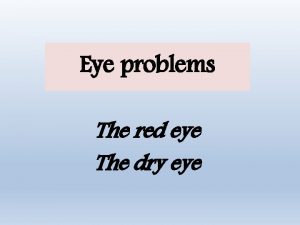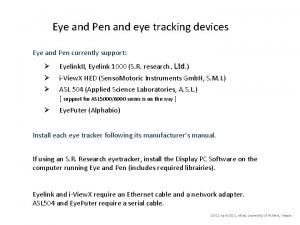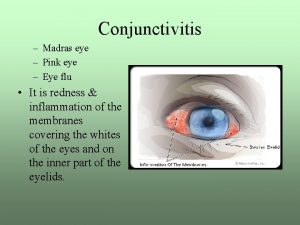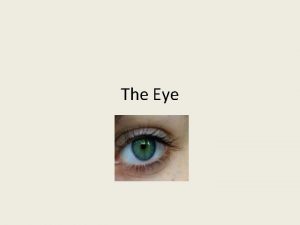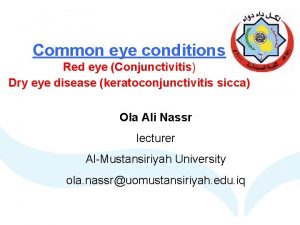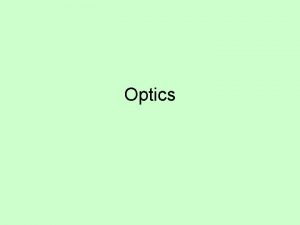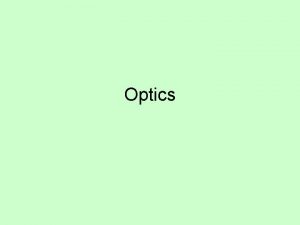Chapter 11 EYE CARE Sara Raftery Mary Clynes






























- Slides: 30

Chapter 11 EYE CARE Sara Raftery, Mary Clynes and Colleen O’Neill

Introduction This chapter explores the requisite standard of eye care within the healthcare setting and walks you through relevant, eye care related procedures. Part 1 – Eye Care Overview Part 2 - Eye Cleansing Overview Part 3 – Eye Irrigation Procedure Part 4 – Eye Drops Procedure Part 5 – Eye Ointment Procedure

Eye Care Eye care is a fundamental aspect of nursing care. A lack of attention to the eye, or poor eye care, can lead to cross infection and may damage the eye, sometimes irreversibly. The aim of eye care is to: • Detect quickly any irritation, damage or disease of the eye and surrounding area. • Prevent injury to the eye and surrounding area. • Prevent eye infections. • Treat eye infections. • Prevent corneal damage in the unconscious patient. • Relieve discomfort. • Irrigate the eye to remove caustic substances from it.

Patients who may require eye care include: • Patients who are unable to attend to eye care themselves e. g. : - Patients with a physical inability or weakness - Severely ill patients - Post operative patients - Unconscious patients (Joyce and Evans, 2006) • Patients with eye infections or eye diseases who require the installation of eye drops or eye ointments. • Patients who have suffered a spillage of caustic substances into the eye (e. g. domestic cleaning agents) and require eye irrigation.

PART 2: Eye Cleansing Overview

General Equipment • Trolley or tray holding: - Sterile eye dressing pack - Gallipot - Non shedding gauze swabs • Disposable waterproof towel • Cleansing solution e. g. 0. 9% Sodium Chloride (or other as advised) • Receiver for soiled gauze swabs

Preparing for Eye Cleansing • Collect and prepare the required equipment in order to carry out the procedure without unnecessary stoppages. • Position the patient in a reclined position, ideally lying in bed with the head resting on pillows to maintain comfort and to ensure ease of access to the eyes. • Ensure the patient’s privacy to promote dignity. • • Explain the procedure carefully to the patient to gain consent and co -operation and minimise patient Wash hands thoroughly using bactericidal handwash and dry hands to reduce the risk of cross infection. • Open and prepare the required equipment.

Procedure for Eye Cleansing • Place disposable towel under the patient’s head and around the neck in case of spillages. • Ask the patient to keep their eyes closed while the eyelids are cleansed, to reduce any risk of corneal abrasion. • Moisten a non-shedding gauze swab with cleansing solution and clean the eyelid from the inner aspect to the outer aspect. Use each swab only once to reduce the risk of cross infection and repeat the procedure until all discharge has been eliminated. • Ask the patient to look up, and swab the lower eyelid from inner aspect to outer aspect, using each swab once to reduce the risk of cross infection. Repeat the procedure until all discharge has been eliminated.

• Take care that the swab does not touch the cornea of the eye, as this can cause damage to the eye. • Dry the eyelid carefully to remove moisture. • Ensure the patient is repositioned in the desired manner on completion of the procedure to promote comfort. • Remove and dispose of equipment to ensure safety. • Wash hands to reduce the risk of cross infection. • Document the procedure in the nursing notes and report any findings to ensure a written record of nursing practice is maintained.

PART 3: Eye Irrigation Procedure

Eye Irrigation Eye irrigation is required to remove corrosive substances that have spilled into the eye. It involves irrigating the surface of the eye with copious fluid to aid removal of the substance from the eye.

Equipment Required for Eye Irrigation • As per general equipment required for eye care • Sterile 0. 9% sodium chloride solution, or sterile water • Towel • Sterile receiver for irrigating fluid • Warm water (in a bowl) to heat irrigating fluid • Irrigating apparatus (irrigating flask or intravenous giving set)

Preparing for Eye Irrigation • Collect and prepare the required equipment in order to carry out the procedure without unnecessary stoppages. • Ensure the patient’s privacy to promote dignity. • Explain the procedure carefully to the patient to gain consent and cooperation and minimise patient anxiety. • Warm the irrigation fluid to body temperature, to ensure the fluid is comfortable for the patient when poured over the eye. • Position the patient in a reclined position, ideally lying in bed with the head resting on pillows to maintain comfort and to ensure ease of access to the eyes. • Incline head to the side which requires eye irrigation, to avoid the irrigation solution or corrosive substance running down the face or into the other eye. • Wash hands thoroughly using bactericidal handwash and dry hands to reduce the risk of cross infection.

Procedure for Eye Irrigation • Place disposable waterproof towel under the patient’s head and around the neck in case of spillages. • If there is any discharge from the eye, clean the area as per the procedure for eye cleansing. • Position the receiver below the affected eye, against the patient’s cheek to collect the irrigation fluid as it drains. • Inform the patient that the eye will be gently held open, as they will be unable to keep their eye open when the fluid is poured in. • Prepare the patient for the procedure by telling them when the irrigation fluid is about to be poured into the eye.

• Pour a little irrigation fluid onto the patient’s cheek initially, so that they are familiar with the temperature and are comfortable with it. • Hold the irrigation apparatus above the eye, making sure it does not touch the eye, and direct the irrigation flow from the inner to the outer aspect of the eye to wash the corrosive substance away from the lacrimal apparatus and the other eye. • While maintaining a constant flow of irrigation fluid, ask the patient to look upwards, downwards, right and left to ensure the entire eye surface is irrigated. • Upon completion, remove the receiver and dry the eyelids using dry, sterile, non-shedding gauze. Dry the patient’s cheek and face using the towel to ensure patient comfort. • Reposition the patient in the chosen position of comfort. • Remove and dispose of equipment to ensure safety. • Wash hands to reduce the risk of cross infection. • Document the procedure in the nursing notes and report any findings to ensure a written record of nursing practice is maintained.

PART 4: Eye Drops Procedure

Eye Drops • Eye drops must be sterile. They are available in single use applicators and multiple application containers. When used in the home, multiple application containers should be discarded after four weeks even if the solution is unfinished. When used in hospital wards it is best practice to discard the bottle after one week (BNF, 2006). • Each patient should have their own separate bottle, labelled with the patient’s name. • If there are particular concerns regarding contamination, individual bottles should be used for each eye. When a patient has eye surgery, new bottles should be used post operatively.

Eye drops frequently contain preservatives. There is an increased risk of contaminating eye drops in preservative free solutions, and when the eye is accidentally touched by the applicator during the installation of eye drops. (Rahman et al 2006). Eye drops must be stored according to manufacturer’s instructions. Many products require refrigeration.

Rationale Eye drops are liquid drug preparations which are introduced to the eye. They may be prescribed for a patient for a variety of reasons. Local anaesthetic eye drops can be used to alleviate discomfort following an eye injury, or may be administered prior to procedures such as: • Eye irrigation • Removal of a foreign body from the eye • Minor eye surgery • Tonometry (measures the pressure within the eye) Antibiotic eye drops may be prescribed to treat eye infections. Anti-inflammatory eye drops may be prescribed to treat inflammatory conditions of the eye. Eye muscle constrictors or dilators may be prescribed. Artificial tears may be prescribed to lubricate the eye when a patient has dry eyes.

Equipment Required for the Installation of Eye Drops • As per general equipment required for eye care • Prescribed eye drops

Arranging for the Installation of Eye Drops • • • Collect and prepare the required equipment in order to complete the procedure without unnecessary stoppages. Explain the procedure carefully to the patient to gain consent and co-operation and minimise patient anxiety. Check the eye drops against the prescription to ensure: - The prescription is for the correct patient. - The prescription is fully completed and signed by a doctor. - The drug is correct. - The dose is correct. - The time the drug is to be administered is correct. - The drug has not expired. - The route for the drug administration is correct. - The eye to which the drug is to be instilled is correct. - The patient is not allergic to the drug. This will ensure that the medication is administered safely and accurately to the patient.

Preparing for the Installation of Eye Drops • • Position the patient with the head tipped back and supported to maintain comfort and to ensure ease of access to the eyes. Wash hands thoroughly using bactericidal handwash and dry hands to reduce the risk of cross infection. If there is any exudate in the eye, cleanse the eye as per the procedure for eye cleansing. Gently shake the eye drop container to ensure even distribution of the drug (Stollery et al, 2005). • Taking care not to touch the cornea, use a nonshedding gauze swab to gently pull the lower eye lid downwards. The swab will absorb excess eye drops. • Ask the patient to look up, and evert the lower eyelid to ensure correct placement of the eye drops on the conjunctiva and not on the cornea, which would cause the patient to blink. • Taking care not to touch the eye hold the dropper just above the eye and place one drop into the lower conjunctiva.

Procedure for the Installation of Eye Drops • • Ask the patient to close the eye gently for approximately one minute, to ensure the drug is absorbed (Stollery et al, 2005). Wipe away any excess solution with the gauze to prevent discomfort and potential eye irritation. Reposition the patient in the chosen position of comfort. Remove and dispose of equipment to ensure safety. Wash hands to reduce the risk of cross infection. Complete the drug prescription document to ensure accurate records of drug administration are maintained. Continue to monitor the patient for effects and side effects of the prescribed drug.

PART 5: Eye Ointment Procedure

Eye Ointment Eye ointments are drug preparations which are introduced to the eye. Eye ointments may be prescribed for a patient for a variety of reasons: • Where a prolonged drug action is desired, eye ointments can be preferable to eye drops. • Antibiotic eye ointments may be prescribed to treat eye infections. • Eye ointments can provide a protective layer for the cornea. • Eye ointments can offer relief if the eye or eyelid is inflamed.

Equipment Required for the Installation of Eye Ointment • As per general equipment required for eye care • Prescribed eye ointment

Arranging for the Installation of Eye Ointment • • • Collect and prepare the required equipment in order to complete the procedure without unnecessary stoppages. Explain the procedure carefully to the patient to gain consent and co-operation and minimise patient anxiety. Check the eye drops against the prescription to ensure: - The prescription is for the correct patient. - The prescription is fully completed and signed by a doctor. - The drug is correct. - The dose is correct. - The time the drug is to be administered is correct. - The drug has not expired. - The route for the drug administration is correct. - The eye to which the drug is to be instilled is correct. - The patient is not allergic to the drug.

Preparing for the Installation of Eye Ointment • Position the patient with the head tipped back and supported, to maintain comfort and to ensure ease of access to the eyes. • Wash hands thoroughly using bactericidal handwash and dry hands to reduce the risk of cross infection. • If there is any residual ointment or exudate in the eye, cleanse the eye as per the procedure for eye cleansing. • Taking care not to touch the cornea, use a nonshedding gauze swab to gently pull the lower eye lid downwards.

Procedure for the Installation of Eye Ointment • Ask the patient to look up, and evert the lower eyelid to ensure correct placement of the eye ointment. • Taking care not to touch the eye, hold the applicator just above the eye and deliver a line of ointment along the lower conjunctiva, from the nasal corner in an outward direction. • Ask the patient to gently close the eye to distribute the ointment across it. • Wipe away any excess ointment with the gauze to avoid irritation to the peri-orbital skin.

• Inform the patient that they may experience a slight blurring of vision for a short period, to minimise any anxiety. • Reposition the patient in the chosen position of comfort. • Remove and dispose of equipment to ensure safety. • Wash hands to reduce the risk of cross infection. • Complete the drug prescription document to ensure accurate records of drug administration are maintained. • Continue to monitor the patient for effects and side effects of the prescribed drug.
 Eye irrigation introduction
Eye irrigation introduction Health care levels primary secondary tertiary
Health care levels primary secondary tertiary Mary wollstonecraft mary a fiction
Mary wollstonecraft mary a fiction Hammurabi
Hammurabi Worms eye view example
Worms eye view example An eye for an eye hammurabi
An eye for an eye hammurabi Pdf
Pdf Hammurabi code an eye for an eye
Hammurabi code an eye for an eye An eye for an eye a tooth for a tooth sister act
An eye for an eye a tooth for a tooth sister act Explain
Explain An eye for an eye meaning
An eye for an eye meaning Every eye is an eye
Every eye is an eye Post operative nursing care
Post operative nursing care Keva eye drops
Keva eye drops Secondary eye care
Secondary eye care Evca eye care
Evca eye care Pope eye care camden ar
Pope eye care camden ar Who guidelines for primary eye care
Who guidelines for primary eye care Components of primary eye care
Components of primary eye care Ehew manual
Ehew manual Standard 3 duty of care
Standard 3 duty of care Magnetul este un corp care atrage
Magnetul este un corp care atrage Palliative care vs hospice care
Palliative care vs hospice care Animale care nasc un singur pui
Animale care nasc un singur pui Care sunt simturile prin care sunt evocate
Care sunt simturile prin care sunt evocate Standard 3 care certificate answers
Standard 3 care certificate answers Hip fracture care clinical care standard
Hip fracture care clinical care standard Care value base health and social care
Care value base health and social care Frankenstein chapter summaries
Frankenstein chapter summaries Mary shelley frankenstein chapter summaries
Mary shelley frankenstein chapter summaries Sara baartman gedig
Sara baartman gedig






